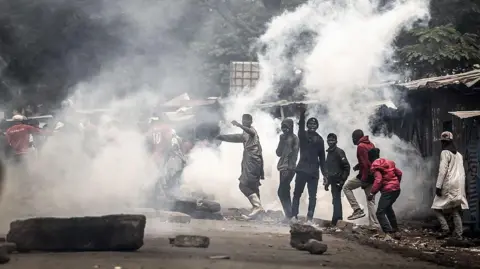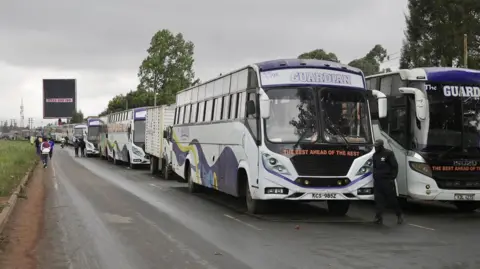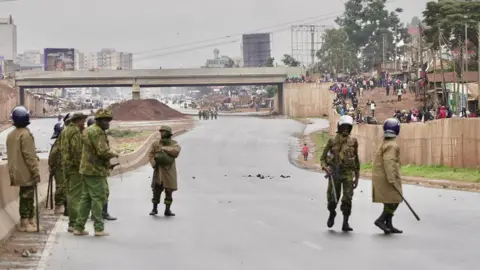Two reported dead in Kenya protests as central Nairobi sealed off
 AFP via Getty Images
AFP via Getty ImagesTwo people have reportedly died of gunshot wounds after police opened fire during protests in Kenya, the latest in a wave of anti-government rallies that began last year.
Dr Aron Sikuku, a medic at Eagle Nursing Home in Kangemi on the outskirts of Nairobi, told the BBC that two bodies had been taken to the facility and had died from gunshot wounds. He said hundreds of protesters had gathered outside his hospital demanding to take away the bodies.
As of now, there has been no official confirmation of the deaths.
The demonstrations mark the 35th anniversary of the historic Saba Saba (7 July 1990) protests that launched Kenya's push for multiparty democracy.
From early morning, security forces blocked all major roads into central Nairobi ahead of the protests. The city centre appeared deserted, with businesses shut and a heavy police presence on the streets.
Elsewhere in Nairobi, clashes broke out as demonstrators lit fires and attempted to breach police cordons. Officers responded with tear gas and water cannon.
The police fired tear gas to disperse people on Thika Road, as well as in Kitengela, a town on the outskirts of the capital. In Kamukunji, near the venue where the original Saba Saba protests were held, police battled groups of protesters who lit fires on the streets.
The rest of the country was largely quiet, although some clashes were reported.
Earlier, hundreds of early-morning commuters and overnight travellers were stranded at checkpoints, some more than 10km (six miles) from the city centre, with only a few vehicles allowed through.
- Why the death of a blogger has put Kenya's police on trial
- Are East African governments uniting to silence dissent?
Within the city, roads leading to key government sites - including the president's official residence, State House, and the Kenyan parliament - were barricaded with razor wire.
Some schools advised students to stay at home.
By mid-morning on Monday, hundreds of overnight passengers remained stranded outside the city centre, with major roads still closed.
Some long-distance buses were parked in Kabete, about 13km from the city centre, with many passengers who could not afford to pay extra money for motorcycle rides to their destinations remaining there.
Humphrey Gumbishi, a bus driver, said they had started their journey on Sunday evening only to find the police road block in the morning.
"We started travelling at 8:30pm last night... We want the government to engage in a dialogue with Gen Zs so all this can come to an end," he told the BBC
 Anthony Irungu / BBC
Anthony Irungu / BBC Anthony Irungu / BBC
Anthony Irungu / BBCIn a statement issued on Sunday evening, the police said it was their constitutional duty to protect lives and property while maintaining public order.
Monday's demonstrations were organised primarily by the so-called Gen-Z young people, demanding good governance, greater accountability, and justice for victims of police brutality, continuing the wave of anti-government protests since last year.
On 25 June, at least 19 people were killed and thousands of businesses looted and destroyed in a day of nationwide protests that were being held in honour of those killed in last year's anti-tax protests.
Recent demonstrations have turned violent, with reports of infiltration by "goons", who are accused of looting and attacking protesters. Civil society groups allege collusion between these groups and the police - accusations the police have strongly denied.
On Sunday, an armed gang attacked the headquarters of a human rights NGO in Nairobi. The Kenya Human Rights Commission (KHRC) had been hosting a press conference organised by women calling for an end to state violence ahead of Monday's protests.
The KHRC spokesman, Ernest Cornel, said that the gang was made up of at least 25 people on motorbikes chanting: "There will be no protest today".
"They were carrying stones, they were carrying clubs… they stole laptops, they stole a phone and they also took some valuables from journalists who were there," he told the BBC Newsday programme.
The original Saba Saba protests were a key moment that helped usher in multiparty democracy in Kenya after years of one-party rule.
The response by the then government under President Daniel arap Moi was brutal. Many protesters were arrested, while at least 20 people were reportedly killed.
Since then, Saba Saba has come to symbolise civic resistance and the fight for democratic freedom in Kenya.
More stories about Kenya from the BBC:
 Getty Images/BBC
Getty Images/BBCGo to BBCAfrica.com for more news from the African continent.
Follow us on Twitter @BBCAfrica, on Facebook at BBC Africa or on Instagram at bbcafrica
